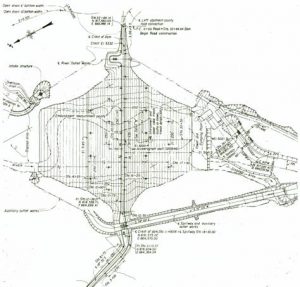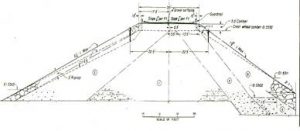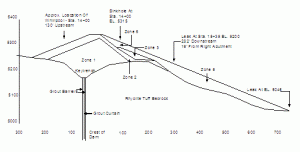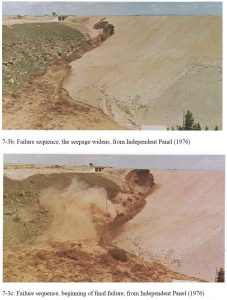Summarized from Solava and Delatte, Lessons from the Failure of the Teton Dam, Proceedings of the 3rd ASCE Forensics Congress, October 19 – 21, 2003, San Diego, California
Introduction
The failure of the Teton Dam during initial filling of the reservoir on June 5, 1976, killed fourteen people and caused hundreds of millions of dollars in property damage downstream. A thorough investigation identified the causes of the failure and suggested improvements for the design and construction of earthen dams.
Dams impound water in vast reservoirs to provide flood control, hydroelectric power, recreation, and other benefits. The earliest use of dams was probably irrigation. Dams have been very useful to the development of civilization. However, the potential energy of the water reservoir can cause considerable damage if the dam fails.
The danger is more than theoretical. Throughout history, dams have failed and lives have been lost. Levy and Salvadori (1992) point out that a dam failure in Grenoble, France, was recorded as early as 1219. For dams built in the United States before 1959, on the average one in fifty failed.
Levy and Salvadori (1992) describe the failures of the South Fork Dam and the Malplasset Dam in detail. The failure of the South Fork Dam on May 31, 1889, released a wall of water 12 meters (40 feet) high traveling at 32 kph (20 mph) that killed nearly 3,000 in Johnstown, Pennsylvania, and other towns. This disaster is known as the Johnstown Flood. More recently, the Malplasset concrete arch dam in France failed on December 2, 1959, when the abutment shifted due to a weak seam in the rock. Almost 400 lost their lives (Levy and Salvadori, 1992).
Some of the factors influencing dam safety and performance can be reviewed through the case of the Teton Dam, a large earthen dam in eastern Idaho that failed on June 5, 1976.
Design and Construction
The Teton Dam was situated on the Teton River, three miles northeast of Newdale, Idaho. It was designed to provide recreation, flood control, power generation, and irrigation for over 40,000 hectares (100,000 acres) of farmland. The Office of Design and Construction, U.S. Bureau of Reclamation (USBR), at the Denver Federal Center, designed the dam and the construction contract was awarded to the team of Morrison-Knudsen-Kiewit in December of 1971.
The preparations for this dam project had been underway for many years. The first active site investigation in the area occurred in 1932 (Teton Dam Failure @ 2002). Between 1946 and 1961, eight alternate sites within about 16 km (10 miles) of the selected site were investigated. Between 1961 and 1970, approximately 100 borings were taken at the site (Independent Panel, 1976).
The design of the foundation consisted of four basic elements: 1) 21 meter (70 foot) deep, steep-sided key trenches on the abutments above the elevation of 1,550 meters (5,100 feet); 2) a cutoff trench to rock below the elevation of 1,550 meters (5,100 feet); 3) a continuous grout curtain along the entire foundation; and 4) the excavation of rock under the abutments (Independent Panel, 1976). These elements for the foundation were important because the types of rock located in this area, basalt and rhyolite, are not generally considered acceptable for structural foundations.
The embankment itself consisted of five main zones. Zone 1 was the impervious center core, which formed the water barrier of the dam. Zone 2 overlaid Zone 1 and extended downstream to provide a layer to control seepage through the foundation. Zone 3 was downstream and its main function was to provide structural stability. Zone 4 consisted of the storage areas downstream from the control structure and the temporary enclosures built to permit the work to be done. Finally, Zone 5 was the rockfill in the outer parts of the embankment (Independent Panel, 1976). Some of these features are shown in Figure 1.
Construction of the dam began in February 1972. When complete, the embankment would have a maximum height of 93 meters (305 feet) above the riverbed and would form a reservoir of 356 million cubic meters (288,000 acre-feet) when filled to the top. The dam was closed and began storing water on October 3, 1975, but the river outlet works tunnel and the auxiliary outlet works tunnel were not opened (Arthur, 1977).
Due to these sections being incomplete, the water was rising at a rate of about 1 meter (3 feet) per day, which was higher than the predetermined goal rate of 0.3 to 0.6 meters (1 to 2 feet) per day for the first year, as set by the U.S. Bureau of Reclamation. However, the increased rate was expected, due to the tunnels being incomplete, and considered acceptable by the Bureau of Reclamation as long as seepage and the water table downstream of the dam were measured more frequently (Independent Panel, 1976).

Figure 1a. Dam Construction Details Plan View (from Independent Panel, 1976)

Figure 1b. Dam Construction Details Cross Section (from Independent, 1976)
Embankment Explanation
- Selected clay, silt, sand, gravel, and cobbles compacted by tamping rollers to 6-inch layers.
- Selected sand, gravel, and cobbles compacted by crawler-type tractors to 12-inch layers.
- Miscellaneous material compacted by rubber-tired rollers to 12-inch layers.
- Selected silt, sand, gravel, and cobbles compacted by rubber-tired rollers to 12-inch layers.
- Rockfill placed in 3-foot layers.
The Failure
On June 3, 1976, several small seepages were noticed in the north abutment wall. Pictures were taken and these leaks were reported to the Bureau of Reclamation. This led to more frequent inspections of the dam. It was now to be inspected daily, and readings were to be taken twice weekly instead of once a week. On June 4, 1976, wetness was noticed in the right abutment and small springs were beginning to appear (Independent Panel, 1976).
On June 5, 1976, the first major leak was noticed between 7:30 and 8:00 a.m. The leak was flowing at about 500 to 800 liters per second (20 to 30 cfs) from the rock in the right abutment. By 9:00 a.m. the flow had increased to 1,100 to 1,400 liters per second (40 to 50 cfs) and seepage had been observed about 40 meters (130 feet) below the crest of the dam (Arthur, 1977).
At 11:00 a.m. a whirlpool was observed in the reservoir directly upstream from the dam and four bulldozers were sent to try to push riprap into the sinkhole near the dam crest (Independent Panel, 1976). Two of the bulldozers were swallowed up by the rapidly expanding hole, and the operators were pulled to safety by ropes tied around their waists (Teton Dam Flood @ 2002). Figure 2 shows a cross section of the dam with the approximate locations of the seepage, the sinkhole, and a whirlpool in the reservoir noted.

Figure 2. Initial failure indications (from Independent Panel, 1976)
Between 11:15 and 11:30 a.m. a 6 by 6 meter (20-foot by 20-foot) chunk of dam fell into the whirlpool and within minutes the entire dam collapsed (Independent Panel, 1976). A slide gallery of the failure sequence, along with some photographs of the dam site today, may be found at http://www.geol.ucsb.edu/faculty/sylvester/Teton%20Dam/welcome_dam.html
The collapse of the dam may be seen at the U.S. Bureau of Reclamation website http://www.pn.usbr.gov/dams/Teton.shtml
At 10:30 a.m. dispatchers at the Fremont and Madison County Sheriffs offices were notified that the dam was failing. An estimated 300 million cubic meters of water (80 billion gallons) headed down the Upper Snake River Valley. The towns in its path included Wilford, Sugar City, Rexburg, and Roberts.
More than 200 families were left homeless. The final toll was 14 killed directly or indirectly and an estimated 400 million to one billion dollars in property damage. Some photographs of the damage downstream may be found athttp://www.lib.utah.edu/spc/photo/p211/p211.html
At the time of failure, the reservoir elevation was 1,616 meters (5,301.7 feet) and was filling at a rate of 1 meter (3 feet) per day. At full capacity, the water surface elevation would have been 1,621.5 meters (5,320.0 feet) (Bureau of Reclamation, 1983).
Investigating Panel
Following the failure, the Governor of Idaho and the Secretary of the Interior selected an independent panel to review the cause of the failure. This independent panel was made up of prominent civil and geotechnical engineers including Wallace L. Chadwick, a former president of the ASCE, and eminent geotechnical engineers Ralph B. Peck, H. Bolton Seed, and Arthur Casagrande. The investigators quickly developed a detailed plan, including field excavation of the failed dam down to the grout curtain and extensive laboratory testing. The panel began work almost immediately and issued its report in December 1976 (Independent Panel, 1976).
Panel Investigation and Results
The panel considered all possible causes of failure and tried to establish the sequence of events leading to the failure. During the investigation, conditions favoring erosion and piping were evaluated. Levy and Salvadori (p. 162, 1992) define piping as the development of tubular leak-causing cavities.
One of the first possible mechanisms considered was increased settling of the structure under the weight of the structure and the water, which would have led to cracking. It was determined that this did not contribute to the failure because the tunnel below the spillway would also have been cracked. Furthermore, earthen dams are relatively flexible and tolerant of differential settlements. The failure hypotheses eliminated included seismic activity, reservoir leakage, and seepage around the end of the grout curtain, as well as differential settlement.
Condition favorable for erosion and piping existed in Zone 1, where the primary materials were highly erodible silts. Wherever this material was subject to flowing water it could be attacked and washed away. This contact could have occurred in three different possible ways. First, seepage through the material could have caused backward erosion. This was determined not to play a major role in the failure since this process occurs very slowly. Second, erosion by direct contact could have occurred where water was in contact with open joints and thirdly, where there was direct contact through cracks in the fill itself. It was determined that these last two were possible and were probably occurring simultaneously (Independent Panel, 1976).
The key trench contained a grout cap overlying a grout curtain that was intended to stop the flow, but the investigation found openings and windows in the grout curtain near the failure section. The review panel also found that the construction of the grout curtain differed from the original design. The intended grouting procedure was to first grout the row of holes downstream, then grout the row of holes upstream, and then grout the center row of holes. This procedure was not followed during construction and the closure between the two outer rows, the center row of grout, was not made. Also, the spacing between the holes was not as specified and gaps were more likely to be present (Independent Panel, 1976). However, there is no way to determine if that had an impact on the erosion. Another impact on the erosion was that the topography near the key trench showed that the foundation was probably poorly compacted, which meant more rapid erosion could occur (Arthur, 1977).
Another cause of failure investigated was hydraulic fracturing near the leaks in the dam. Hydraulic fracturing causes cracking when the sum of the normal and tensile stresses exceeds the porewater pressure. It was determined that due to the cracks that had already existed, the pressure beneath the key trench was less than full reservoir pressure. In other words, due to the fact that the grout curtain was not fully effective, the failure was probably not due to hydraulic fracturing. However, hydraulic fracturing may have been a factor in the initial breaching of the key trench fill (Independent Panel, 1976).
The failure is best overall explained in the Review to the Department of Interior by the Independent Panel as, … caused not because some unforeseeable fatal combination existed, but because (1) the many combinations of unfavorable circumstances inherent in the situation were not visualized, and because (2) adequate defenses against these circumstances were not included in the design (pp.12-18, Independent Panel, 1976)
The panel summarized its conclusions (pp. vii-ix, Independent Panel, 1976):
- The pre-design site and geological studies were appropriate and extensive.
- The design followed well-established USBR practices, but without sufficient attention to the varied and unusual geological conditions of the site.
- The volcanic rocks of the site are highly permeable and moderately to intensely jointed.
- The fill soils used, wind-deposited nonplastic to slightly plastic clayey silts, are highly erodible. The soil classification was ML.
- The construction was carried out properly and conformed to the design except for scheduling.
- The rapid rate of filling of the dam did not contribute to the failure. If the dam had been filled more slowly, a similar failure would have occurred at some later date.
- Considerable effort was used to construct a grout curtain of high quality, but the rock under the grout cap was not adequately sealed. The curtain was nevertheless subject to piping too much was expected of the grout curtain, and the design should have provided measures to render the inevitable leakage harmless.
- The dams geometry caused arching that reduces stresses in some areas and increased them in others and favored the development of cracks that would open channels through the erodible fill.
- Finite element calculations suggested that hydraulic fracturing was possible.
- There was no evidence of differential foundation settlement contributing to the failure.
- Seismicity was not a factor.
- There were not enough instruments in the dam to provide adequate information about changing conditions of the embankment and abutments.
- The Panel had quickly identified piping as the most probable cause of the failure, then focused its efforts on determining how the piping started. Two mechanisms were possible. The first was the flow of water under highly erodible and unprotected fill, through joints in unsealed rock beneath the grout cap, and development of an erosion tunnel. The second was cracking caused by differential strains or hydraulic fracturing of the core material. The Panel was unable to determine whether one or the other mechanism occurred, or a combination.
- The fundamental cause of failure may be regarded as a combination of geological factors and design decisions that, taken together, permitted the failure to develop.
The Panel further described the geological factors as numerous open joints in the abutment joints and scarcity of better fill material than the highly erodible soil. the design decisions were complete dependence for seepage control on a combination of deep key trenches filled with windblown soils and a grout curtain,a geometry of the key trench that encouraged arching, cracking, and hydraulic fracturing in the backfill, using compaction of the fill as the only protection against piping and erosion, and failure to provide for the inevitable seepage (pp. ix-x, Independent Panel, 1976).
Another factor was the poor compaction of the aeolian silt fill material. It was compacted at less than the optimum moisture content. The material, as compacted in the dam, permitted continuous erosion channels (pipes) to be formed in the core without any evidence of their existence becoming visible. (p. 7-14, Independent Panel, 1976).
Lessons Learned
The lessons learned from this case may be divided into two categories. In addition to the technical aspects of the failure, professional and procedural factors also influenced the course of events. The lessons learned also have implications for engineering education.
Technical Aspects. The failure of the Teton Dam could have been avoided. Early investigations into the geology of the site showed that the rocks in the area were almost completely of volcanic origin. These volcanic rocks consisted of basalt and rhyolite. In the footnotes to the geological survey of January 1971, the rhyolite is defined as lightly to locally highly fractured and jointed, relatively light weight (pp. 4-7, Independent Panel, 1976). This was also the condition for other possible sites located upstream of the site where the dam was constructed. These materials are usually avoided due to a history of erosion and deposition. The reason for the extensive foundation was the poor quality of the underlying material, including the grout curtain. The grout curtain failed to do its job of preventing these materials from being easily washed away.
The panel noted that the design did not provide for downstream defense against cracking or leakage, and did not ensure sealing of the upper part of the rock under the grout cap. The grout curtain was not constructed in three rows, and the reliance on a single curtain was judged to be unduly optimistic. The dam and foundation were not instrumented sufficiently to warn of changing conditions.
Professional/Procedural Aspects. At the first sign of a problem, the people at the dam site informed the Bureau of Reclamation. The Bureau did not immediately inform the public due to fear of panic and because there were initially no signs of imminent danger, but the public was warned about 45 minutes before the collapse (Arthur, 1977). It was determined that the people involved acted responsibly and were not punished for their involvement. However, the failure of the Teton Dam brought about changes in dam construction and operation by the Federal Bureau of Reclamation to ensure safety.
On the 25th anniversary of the disaster, Ken Pedde, the Acting Regional Director of the Pacific Northwest Region of the USBR, reviewed the lessons that had been learned. Some of the changes in the process of dam design and construction include peer review of dams, special treatment for fractured rock foundations, and frequent site visits during construction by the design engineer. Also, redundant measures began to be used to control seepage and prevent piping (The Failure of Teton Dam @ 2001). Pedde’s address can be found at http://www.pn.usbr.gov/news/01new/dcoped.html
This failure also made each federal agency review their dam safety activities and Congress passed several acts that authorized a national Dam Safety Program. These reviews and programs brought about annual dam inspections and the installation of instruments to monitor dams. Also, the Reclamation Safety of Dams Act of 1978 provided funds to analyze and modify existing structures that were determined to be potentially unsafe (The Failure of Teton Dam @ 2001).
Educational Aspects. This case demonstrates the importance of engineering geology and geotechnical engineering for civil engineering students. Engineering geology is important for the evaluation of the suitability of foundation and borrows or fill materials. In this instance, both the rhyolite under the dam and the fine aeolian silt used as a fill material were deficient. Ironically, better borrow material was available in the valley downstream from the dam site, but the USBR decided that using it would be environmentally disruptive (Independent Panel, 1976).
It is also important to compact fill materials to the maximum density at or near the optimum moisture content. In this case, the material was too dry and was not sufficiently compacted (Independent Panel, 1976).
The static hydraulic pressure may also be determined using the height of the dam of 93 meters (305 ft.) and the height of the water of 86.1 meters (282.4 ft.). The pressure increased continually as the dam was filled. Also, this case can be used to review aspects of professional practice such as the responsibility of reviewing designs and using redundant measures to ensure the safety of the public.
From the failure of Teton Dam, many lessons were learned. One of these lessons is that a dam site must have solid foundation material. An effective grout curtain may be an effective way of dealing with this unsuitable material, but only if there is a way to check if the grout curtain is an effective barrier once it is in place. Also, this failure showed that dams must be designed so that pressure can be decreased if necessary. This was especially important in this case since the dam was allowed to begin filling while other parts were still under construction.
Summary and Conclusions
The case may be best summarized in the words of the panel report the Panel concludes (1) that the dam failed by internal erosion (piping) of the core of the dam deep in the right foundation key trench, with the eroded soil particles finding exits through the channels in and along the interface of the dam with the highly pervious abutment rock and talus, to point at the right groin of the dam, (2) that the exit avenues were destroyed and removed by the outrush of reservoir water, (3) that openings existed through inadequately sealed rock joints, and may have developed through cracks in the core zone of the key trench, (4) that, once started, piping progressed rapidly through the main body of the dam and quickly led to complete failure, (5) that the design of the dam did not adequately take into account the foundation conditions and the characteristics of the soil used for filling the key trench, and (6) that construction activities conformed to the actual design in all significant aspects except scheduling. (pp. iii-iv, Independent Panel, 1976).
In the design and construction of earth dams, it is necessary to select proper materials that are sufficiently resistant to piping and to ensure that they are compacted to the proper density. If a grout curtain is used, methods must be available to ensure that it is continuous and forms a seal with the underlying rock. The design should be incorporated adequate defense against cracking and leakage. Finally, dams must have sufficient instrumentation to provide early warning of piping and impending failure.
As a final comment, this case stands as a warning against overconfidence and hubris. As every dam engineer knows, water also has one job, and that is to get past anything in its way (p. 93, Macauley, 2000).
Print References
Arthur, H.G. (1977) Teton Dam Failure. The Evaluation of Dam Safety: Engineering Foundation Conference Proceedings, ASCE, New York, New York, 61-71
Independent Panel to Review Cause of Teton Dam Failure (1976). Report to the U.S. Department of the Interior and the State of Idaho on Failure of Teton Dam. Idaho Falls, Idaho. December 1976
Macauley, D. (2000). Building Big, Houghton Mifflin Company, New York, New York.
Teton Dam Disaster.Hearings Before a Subcommittee on Government Operations House of Representatives, 94th Congress, Second Session, August, 5, 6, and 31, 1976
Levy, Matthys, and Salvadori, Mario (1992). Why Buildings Fall Down. W. W. Norton & Company, New York, N. Y.
U.S. Bureau of Reclamation, Pacific Northwest Region, (1983) Teton Basic Project, Lower Teton Division; Idaho; Fremont, Madison, and Teton Counties.
West, Terry R. (1995) Geology Applied to Engineering, Prentice Hall, New Jersey.
Web References
U.S. Bureau of Reclamation, dam website http://www.pn.usbr.gov/dams/Teton.shtml
The Failure of Teton Dam, U.S. Bureau of Reclamation, News Release (online) available 6/5/2001 (2001). < http://www.pn.usbr.gov/news/01new/dcoped.html>
Teton Dam Failure (2002). <http://www.geol.ucsb.edu/~arthur/Teton%20Dam/welcome_dam.html>
Teton Dam Flood. (2002). <http://www.ida.net/users/elaine/idgenweb/flood.htm> (Dec. 23, 2002) – Survivor’s account
Damage downstream http://www.lib.utah.edu/spc/photo/p211/p211.html
Slide presentation http://www.xgiguy.com/Teton%20Dam%20Failure_files/frame.htm
Illustrations from Chapter 7 of the book Beyond Failure: Forensic Case Studies for Civil Engineers, Delatte, Norbert J., ASCE Press.








